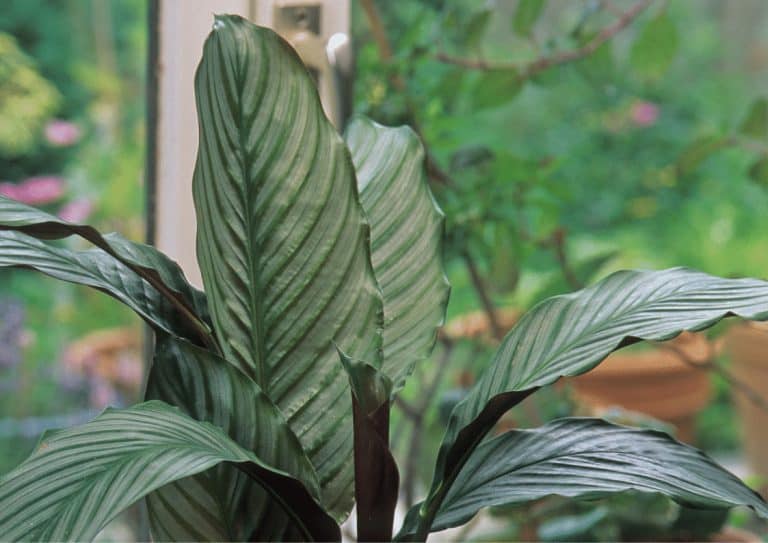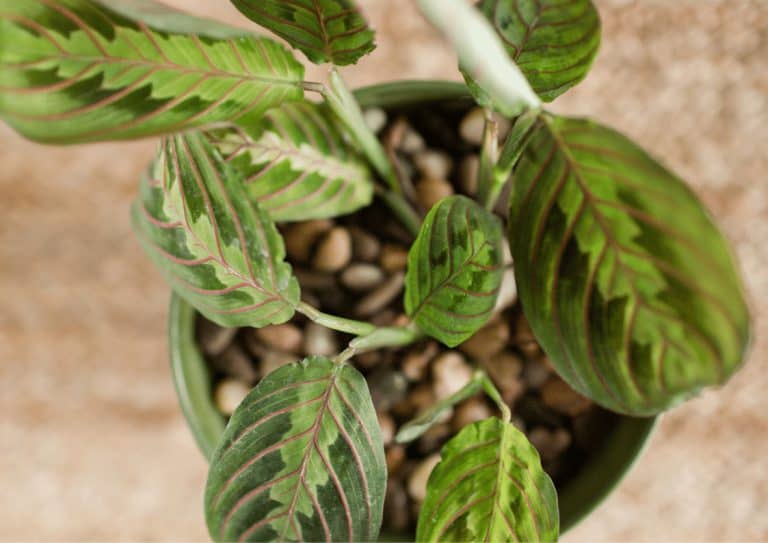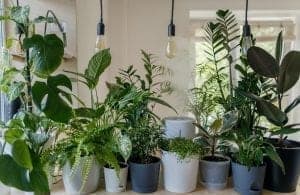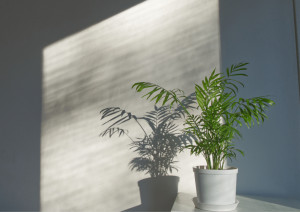Why Do Calathea Leaves Curl At Night?
- Lakeisha Ethans
- September 13, 2022
If you buy something using the retail links in our articles, sometimes we earn a small affiliate commission. This does not impact the products we recommend.
Calathea is a flowering plant genus commonly known as the “prayer plant.” The genus contains approximately 60 species and has colorful, vibrant leaves, typically with variegation throughout and bright hues on the undersides. These leaves are unfurled during the daytime to absorb sunlight, but at night, they seem to curl or fold up and “stand” upright.
This feature of leaf movement is somewhat unusual and can be very fascinating to watch. Since curling leaves are often a negative symptom of a problem with a plant’s care, the natural curling of Calathea leaves can be a perplexing physiological phenomenon.
We know how it happens, but answering why it happens is a different matter.
There is no pure consensus on why Calathea leaves curl and stand up at night, and expert botanists have different theories. It may be a form of protection against pests or fungal infections, a means of regulating temperature, or a method for moisture collection. The adaptation may also be due to many or all of the abovementioned.

The curling of the leaves of a Calathea is a unique form of movement that only exists in certain plant families. In this article, we’ll explore this leaf movement by answering questions such as:
- How do Calathea leaves curl at night?
- What are the theories on why Calathea leaves curl at night?
- What do Calathea leaves look like when curled at night?
- What does it mean if my Calathea leaves don’t curl at night?
This post aims to help you better understand the purpose, mechanisms, and physiology of the curling of Calathea leaves while providing general information that you should know about the process.
How do Calathea leaves curl at night?
Calathea leaves move to stand semi-vertically at night through a process known as nyctinasty, which is a type of everyday schedule that certain higher plants follow. It is essentially a form of circadian rhythmic movement that occurs in response to darkness and the sun’s setting. In other words, it’s almost like the plant is asleep.
Through this process, Calathea plants regularly move in small motions throughout the day, responding to the changing of light intensity. Their biggest change, of course, occurs at night, when the leaves begin to “stand up” and point upward as if praying – which is the source of their nickname.
This movement is driven by a specialized organ in the Calanthea plant called the pulvinus. This organ is a tube filled with cells with very thin walls. These cells, situated at the base of each leaf, are capable of very quickly shrinking and swelling by releasing or absorbing water.
When the pulvinus changes its size, the leaves move due to the shifting weight. This allows for a simple, straightforward leaf-movement process that can be facilitated as needed in response to changing sun intensities.

What are the theories on why Calathea leaves curl at night?
The first and most widely accepted theory is that Calathea leaves stand up to optimize their ability to absorb water and regulate water loss. When close to vertical in position, the leaves may be able to help direct water vapor and raindrops down to their roots so they don’t remain in beads on the surface of the leaves.
Curled or standing leaves also have a lower surface area, meaning they don’t lose as much water. The same goes for temperature, as the vertical leaves of the Calathea can prevent excessive heat loss, so the plant doesn’t get too cold at night.
Another popular theory is that the standing leaves of the Calathea are a protective mechanism against numerous potential threats. For example, a lack of moisture pooling can reduce the risk of fungal infections, and the smaller exposed surface area means that insects and pests have less space to latch onto.
Ultimately, the process of leaf movement in Calathea plants is likely related to survivability, though the specific genuine reason remains unconfirmed. There are likely numerous potential benefits to the process as opposed to just one single reason for the behavior.
What do Calathea leaves look like when curled at night?
The nickname “prayer plant” can provide an incorrect idea of what actually happens to Calathea leaves when night falls. For example, there’s a common misconception that Calathea leaves will therefore press themselves together in a very close resemblance to praying hands, but this is not the case.
Calathea leaves rotate upward when curled, so their tips point to the sky or ceiling. However, they may not close entirely and are unlikely to push against each other. Regardless, they appear partially vertical and notably differ in position from their daytime selves
Calathea leaf edges should also not actually curl at night. This indicates poor environmental conditions, such as excessive sun exposure, poor humidity, bad temperature, and incorrect watering methods.
What does it mean if my Calathea leaves don't curl at night?
All Calathea plants are known to “close up” as night falls. This means that if yours doesn’t, something is wrong.
The most common cause of Calathea leaves not properly curling at night is excessive light. After all, the plant responds to light intensity, regulating its circadian rhythm based on this factor. Therefore, if its environment is too bright, even due to artificial lighting, the plant may be unable to register the progression of day into night.
In the wild, the Calathea grows beneath tall canopies of other trees. This means that filtered, indirect light is simply best for it. However, large amounts of light will burn the leaves and make it difficult for the plant to move into its night-time position. As such, you must ensure that the plant is placed in a relatively dark environment when night falls.
Another cause for incorrect Calathea leaf movement is incorrect watering. Since these movements are regulated by the pulvinus, which relies on water collection and release to change leaf positions. Too much water will cause the pulvinus to swell, pushing the leaves into a standing position. Too little will cause the pulvinus to remain shrunken, unable to lift the leaves.
Overwatering can also lead to root rot and waterlogged soil, which is a serious and life-threatening problem for a plant. A Calathea faced with this environmental issue will lose its ability to perform its normal functions, including its leaves’ regular furling and unfurling. Therefore, it is essential to transplant and treat a waterlogged Calathea as quickly as possible to avoid death.
Other potential causes for lack of proper Calathea leaf movement are suboptimal humidity levels, suboptimal ambient temperatures, pest infestation, disease, and stress due to environmental changes. Damaged or aging leaves may also lose the ability to properly curl as needed, as the leaves may not be able to move like they used to.
Take home message
The exact reason that Calathea leaves curl at night is not fully known, but there are plenty of intelligent guesses. The process may reduce moisture and heat loss, prevent pest infestations or fungal infections, and help to direct water down to the plant’s roots. It may also do all of the above, serving multiple purposes at once.
Calathea leaves know to move at night due to a circadian rhythm movement process called nyctinasty, where they respond to the intensity of light around them. An organ aids this on the base of the leaves that shrinks and swells with moisture as needed to change the position of the leaves.
If your Calathea leaves aren’t closing, that is likely a cause for concern. In most cases, the concern is minor and can be easily addressed without risking the plant’s health, such as needing a change in light exposure. However, in other cases, this can signify something more serious, such as root rot, disease, or pest infestation. Make sure your Calathea receives the care it needs to avoid this problem!

Chris Dosser
Co-Founder of Eden Indoors
Chris is a self-taught horticulturist with over a decade of experience caring for houseplants and creating lush, thriving indoor oases. He specializes in Monstera, and by self admission has a serious problem with buying and propagating rare indoor plants!
Similar Posts
Do Normal LED Lights Help Houseplants Grow?
If you, like us, are just keen to keep your office plants alive and really don’t care all that much about the rate of growth or the yield of the plant then...
12 Tall Office Plants That Thrive In Low Light Conditions
Office environments aren't known for their access to natural light, which can make finding tall plants for such spaces difficult. Here's 12 tall plants that tolerate low light conditions.



